Dirty Twitter review of the VS7.0-ER
The internal perfectionist of the author of previous reviews did not allow photographing “dusty” bicycles, which could give the impression that no one had ridden them and the review was written “from pictures from the Internet”. No, no, no, and again no: we’ll ride on everything, “in the tail and in the mane” - on asphalt and sand, in heat and rain, with dust and drops - this is the only way to “feel” a piece of iron and form an impression of it .
Today there will be a dirty review of one of the most affordable electric bikes from Twitter (no, not the same one) - VS7.0-ER (do not try to immediately remember the name of the model). Let's enjoy!
Surveys of any alternative vehicle traditionally begin with a thick cloud that all other ways of moving are terrible. We will not make exceptions :)
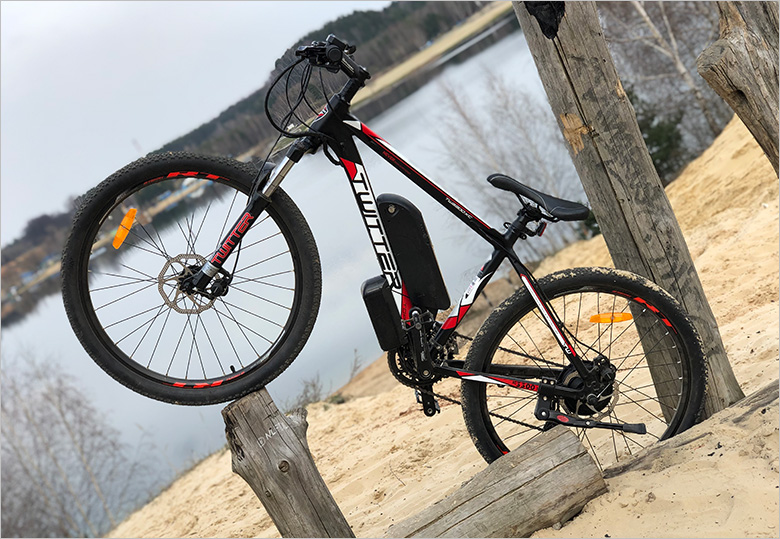
In large cities (especially in Moscow), a car is increasingly turning from a means of transportation into a luxury: gasoline, traffic jams, parking, taxes, thousands of fines. But abandoning a personal car can be difficult - each of us has situations where neither a taxi nor car sharing will replace it. Metro, buses, trams ... yes, everything is fine, but often you need to get to the same metro, and public transport is rigidly tied to routes and not always convenient.
Scooters, monowheels, rollers? Yes, it is compact, maneuverable and economical, but all this is convenient only at short distances - it’s obviously inconvenient to go from the Moscow region to the center on roller / monowheels. Whether it’s an electric bike business, he sat down and rode away: at least for 20 km, at least for 50, if you want to drive a motor, if you want by the power of your two, you definitely won’t have to drag. Well, plus the health benefits and shape. Anyway, summer is made for a bicycle. What is needed?
In the model range of the VS7.0 line there are already three versions of electric bikes : VS7.0-ER100 , VS7.0-ER and VS7.0-EM . Visually, they look almost the same, but only one letter / number significantly affects both the characteristics and the price. We have already briefly talked about this in a consolidated publication , but it will not be a sin to repeat it.
Today there will be no photos without specks of dust, to the comments “how can you give a bike like that!” we are ready. Moreover - we plan to make a separate publication about the maintenance of a bicycle by the example of a tricked two-suspension (which fell most of all under distribution) - would it be interesting to read? Write your questions in the comments.
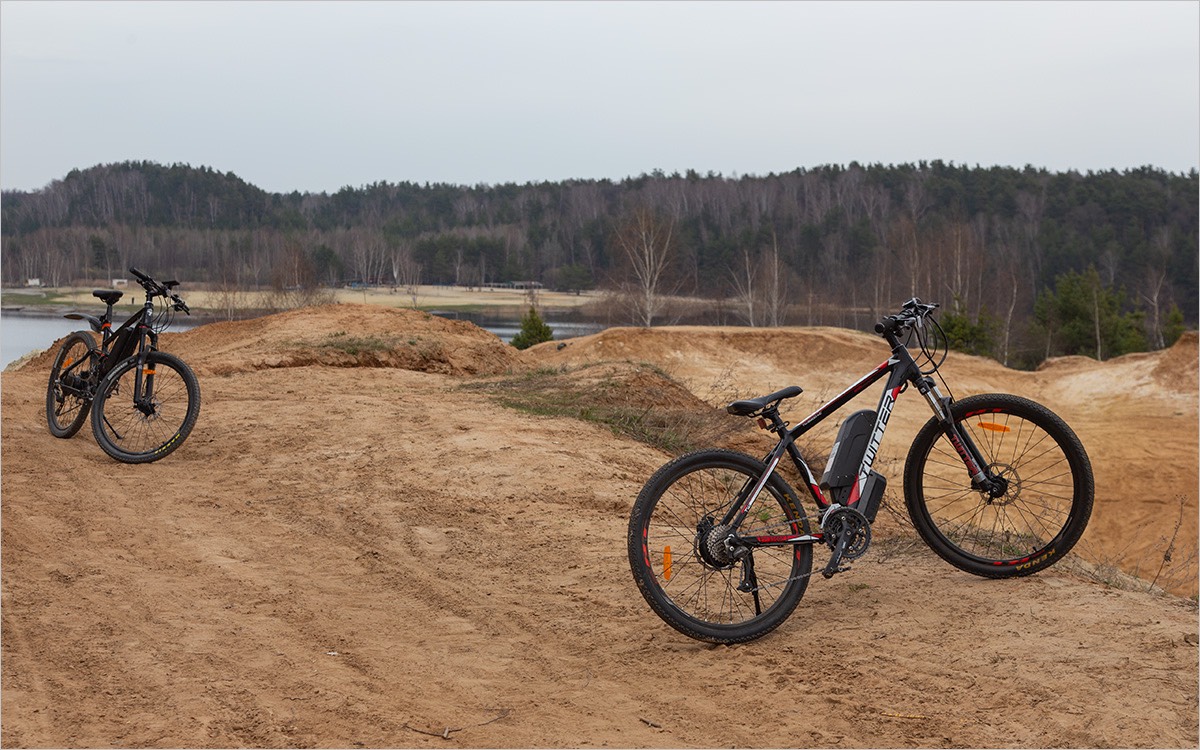
The bike starts with a frame. The VS7.0-ER is a typical aluminum (6061) triangle with a size of 17 "- the 15-inch version (as, for example, the Mantis line) or some other is not here. The upper and lower pipes of the frame have a slightly" triangular "section, while the seatpost is round, and neat seamless welding is used, which adds points to the look of the bike.

But what removes the points is the controller unit located under the bottom of the frame - it looks somewhat bulky and unusual, in the models from the previous review all the electronics were hidden either in the battery (in the Mantis series models) or in the frame itself (as in the carbon TW -E9L ). But there are pluses in this - servicing such a unit (in which case) will be easier than picking the same frame. On the go, this box also does not interfere in any way - it is not the bottom point and does not hurt anything.
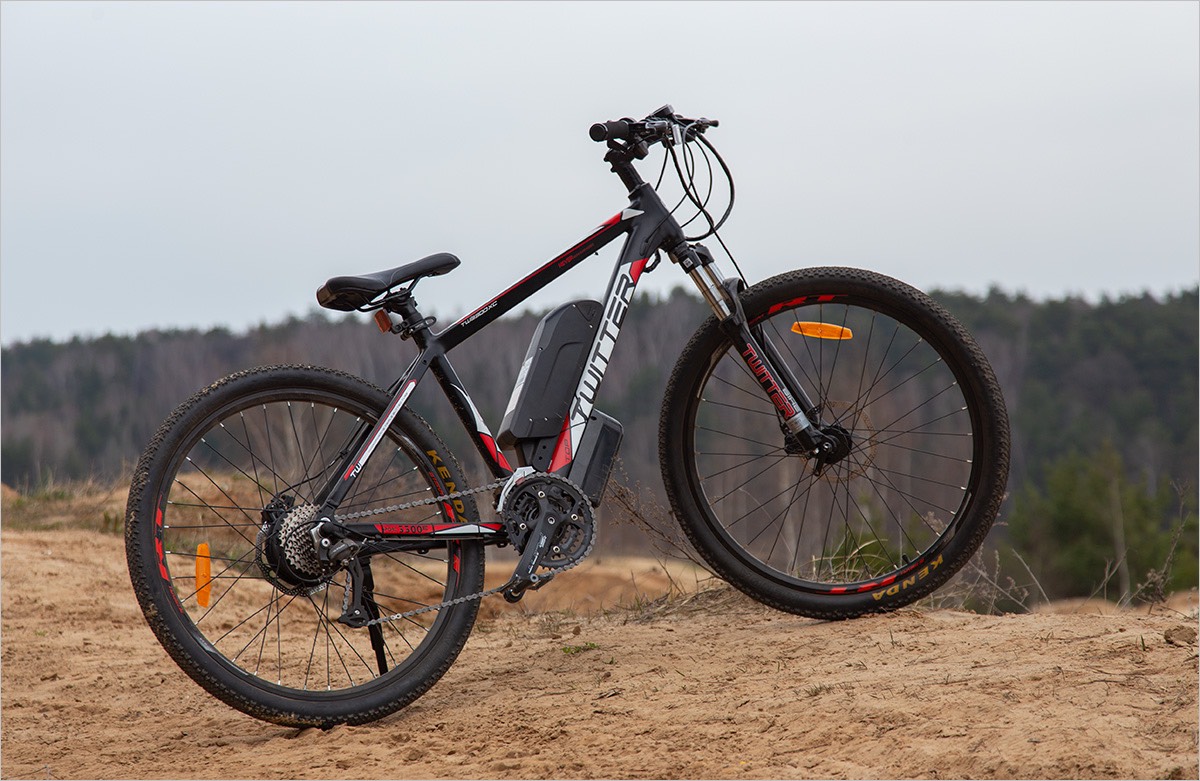
The bicycle’s battery is located on the bottom tube of the frame - it is removable (worn along the guide), with a mechanical anti-theft lock (2 keys in the kit) and with a charge indicator (there is a separate button for this).

He also has a rubberized plug under which there is a USB-connector for charging devices, a connector for charging the battery itself and a button for turning it off in hardware.
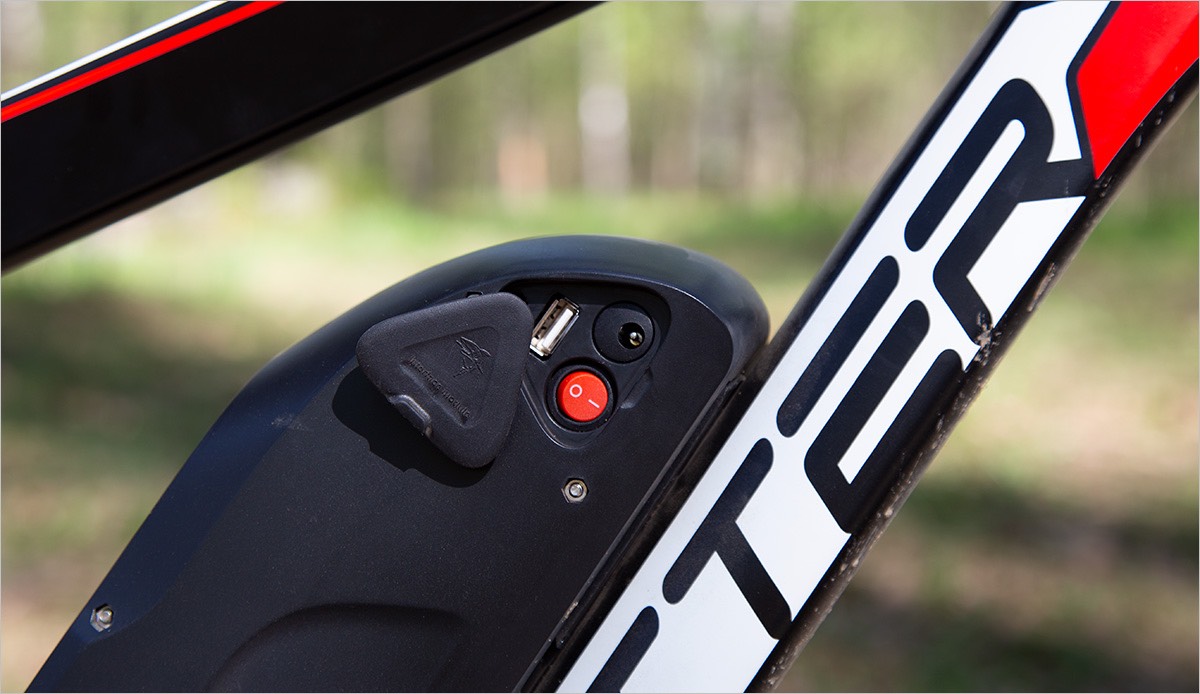
The USB connector turns the bike into a large power bank: if you want, charge the smartphone (the same trackers quickly erase the charge of the smartphone), you want the column (which you have nowhere to attach), you want the flashlight. U - convenient.
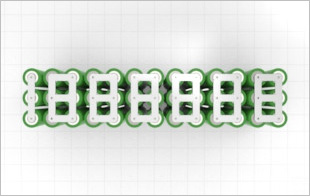 The battery capacity is 480 Wh (48 V, 10 Ah). Inside - lithium-ion cells of LG (judging by the name of the model, CBT-13S3P, there are 13 consecutive blocks of 3 parallel cells of 18650) - the manufacturer claims up to 120 km on a single charge in the assist mode.
The battery capacity is 480 Wh (48 V, 10 Ah). Inside - lithium-ion cells of LG (judging by the name of the model, CBT-13S3P, there are 13 consecutive blocks of 3 parallel cells of 18650) - the manufacturer claims up to 120 km on a single charge in the assist mode.
A lot, a little? How many trips do you drive 120 km?
There are three stars in the front cassette, 9 in the back, a total of 27 speeds. You will once again write that you can’t ride all of them for a long time, but you won’t argue against mathematics - 3 by 9 equals 27 :) Cassette - SUGEK-9S (11-34T), choosing a comfortable riding mode is not a problem.

As mentioned above, the Shimano Altus kit (more precisely the M370) is responsible for switching speeds here - an inexpensive and relatively high-quality switch designed for entry-level and mid-range MTBs.
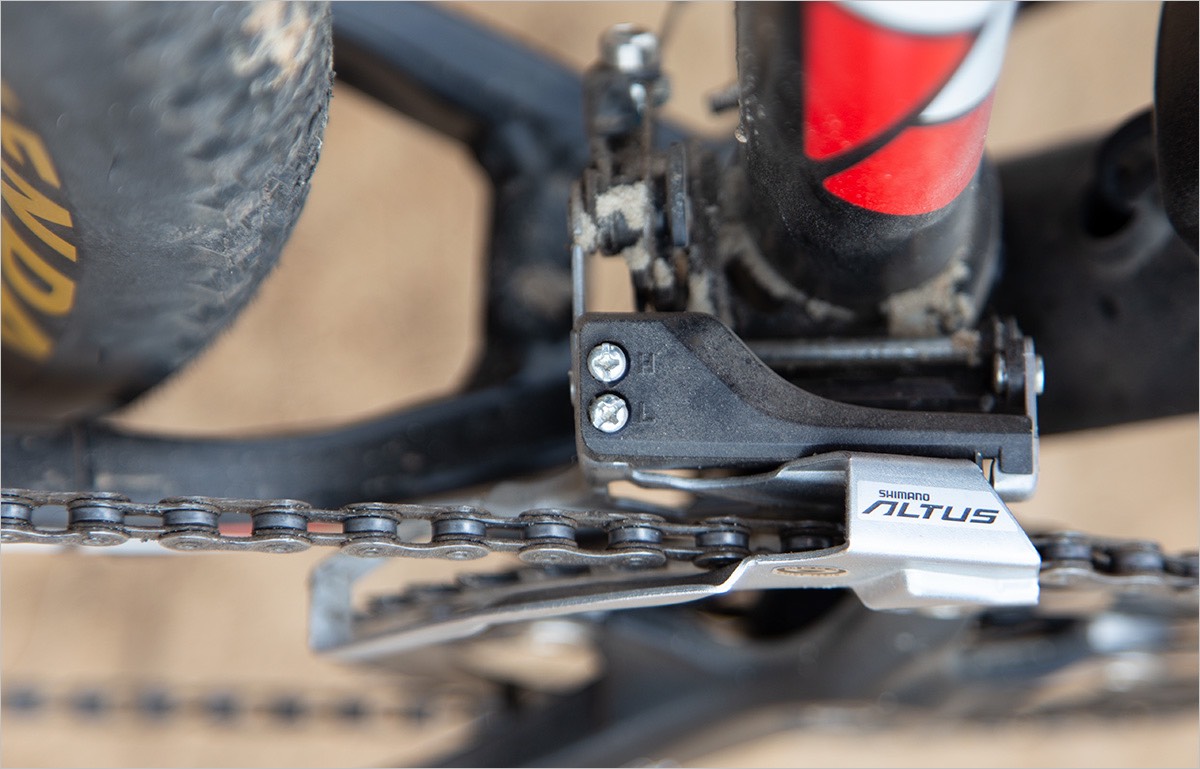

The manufacturer calls the design of the switch low profile (like the frame is pressed closer to the cassette stars - for better switching, less resistance and to make the hair smooth and silky), as well as increased dirt resistance. We checked on several long and "dirty" trips - the flight is normal. There is a cable tension adjuster for fine tuning.

Chain YBN-9S
Brakes - mechanical disc. Shimano Tourney TX - suitable for Altus class, simple and unpretentious, with perforated discs and fairly large pads.



By the way, yes, the wheels are 26-inch, with a Retrospec rim (as in previous models, almost all the equipment here is from this brand) and KENDA-1187 tires (26 "× 1.95"). The same tires were in more MTB models, for example, in Twitter Mantis - nothing has changed since the last reviews, they are still as comfortable driving around the city and offroad.

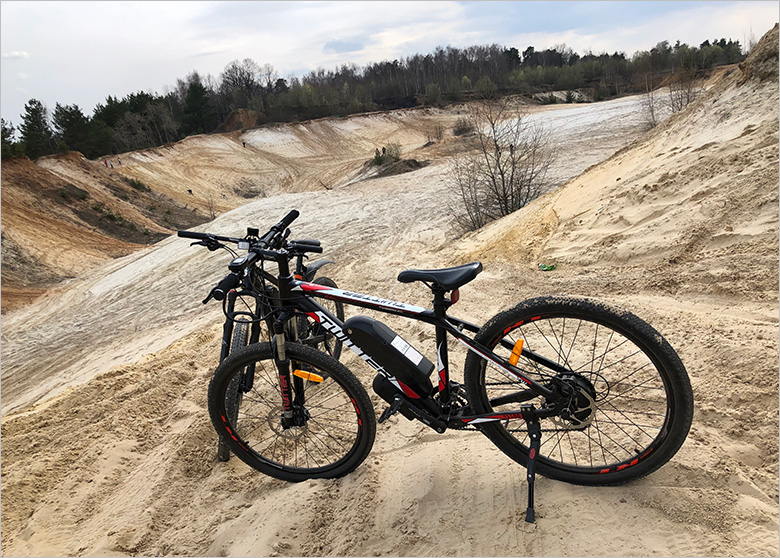
A brushless electric motor (gear motor-wheel) with the marking 48V350W18054609 is built into the rear wheel. I'm certainly not a doctor, but there is a feeling that it is designed for a voltage of 48 V, and the power is 350 watts. That technical specifications confirm :) The gearbox has a freewheel (so as not to expend energy when driving on muscular traction). About the impressions of riding on such a motor - a little later.

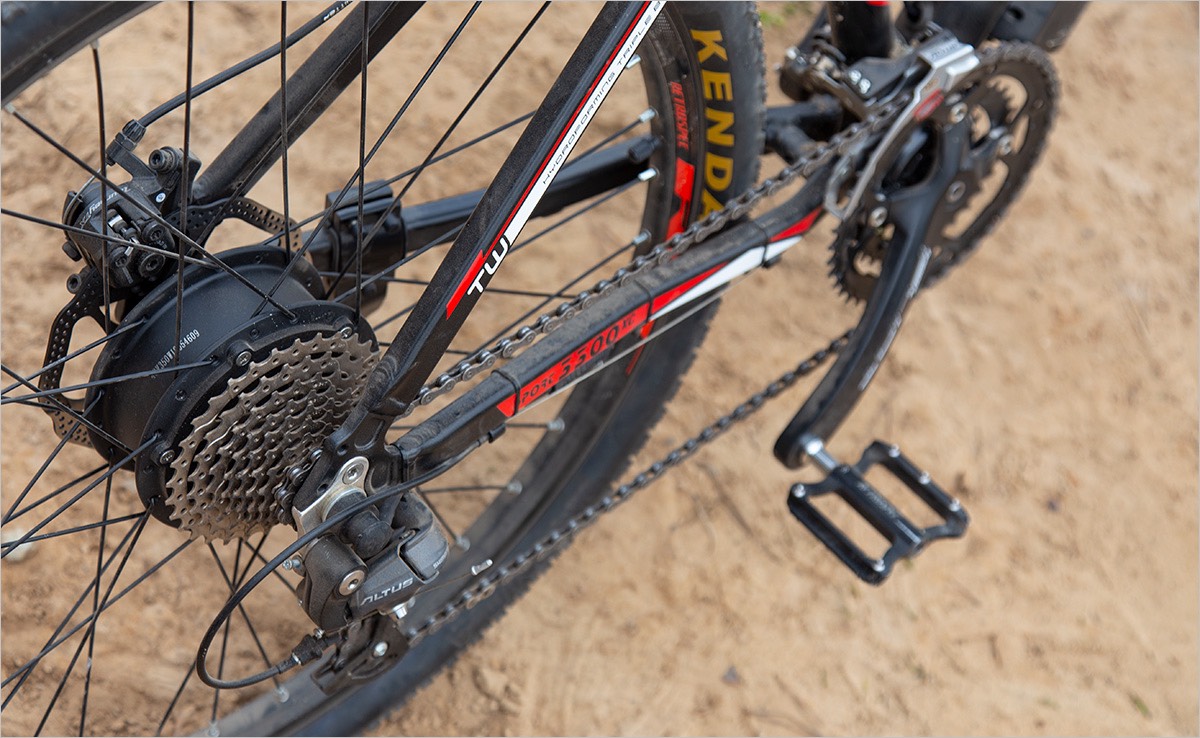
The seat post allows you to adjust the seat height (convenient eccentric) in a fairly wide range - from "bmx-style" to "for a special project " :) The seat is made of eco-leather, comfortable, does not rub over long distances.

Two reflectors are included in the kit: one is just under the saddle, the second is on the steering wheel.

Cranks and pedals from Retrospec - more than once met, no complaints. Also, the bike is equipped with a footrest installed on the rear left feather - so that the bike can be beautifully placed and inform social networks the next trip.


The front wheel has a suspension fork with the ability to lock it (manual) and adjust the “preload” (fork position in a state of static load). The stroke is about 100 mm. There is no rear shock absorber - we have an inexpensive hardtail for the city and parks :) But it’s worthwhile to pay tribute, riding with even one shock absorber is quite comfortable.

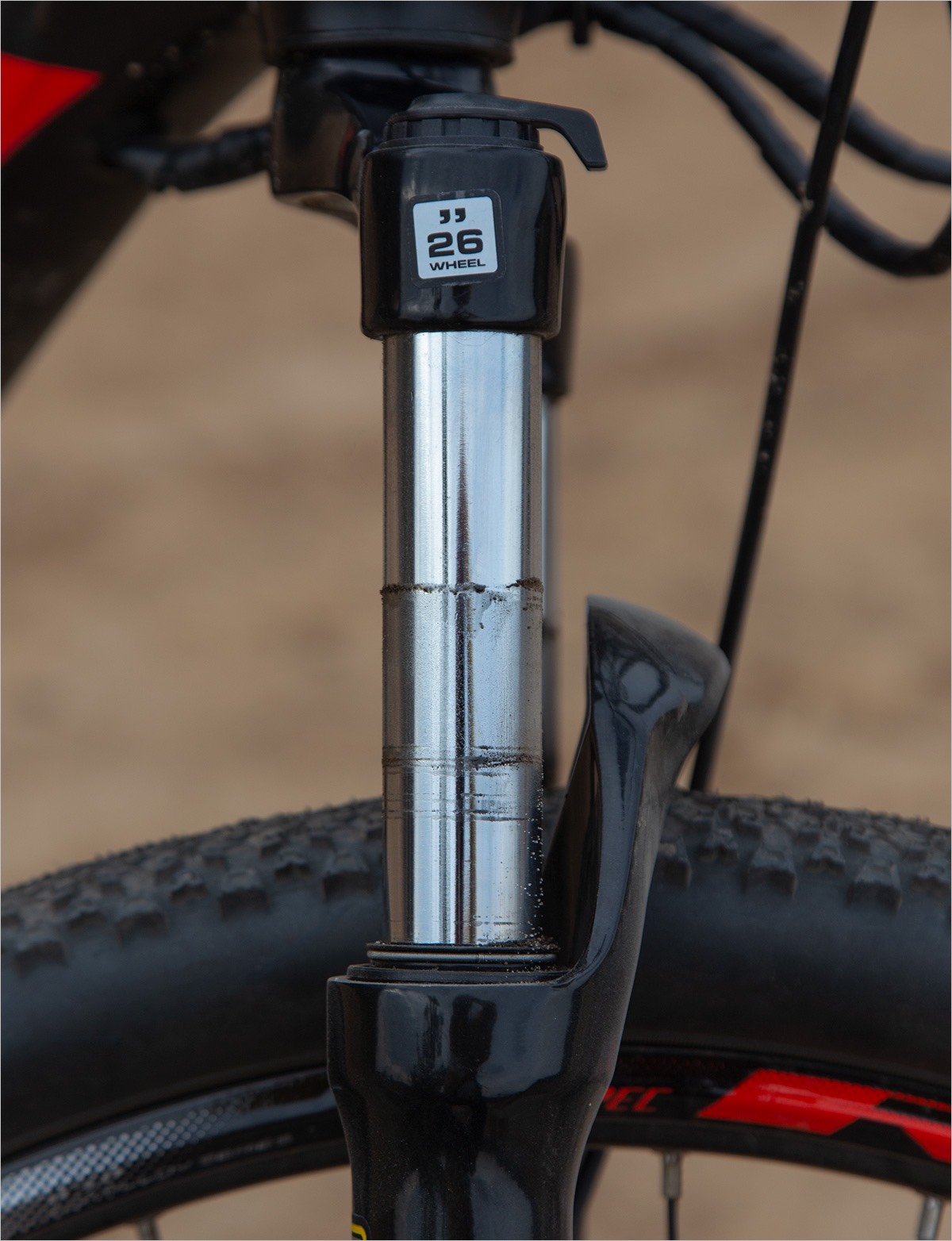
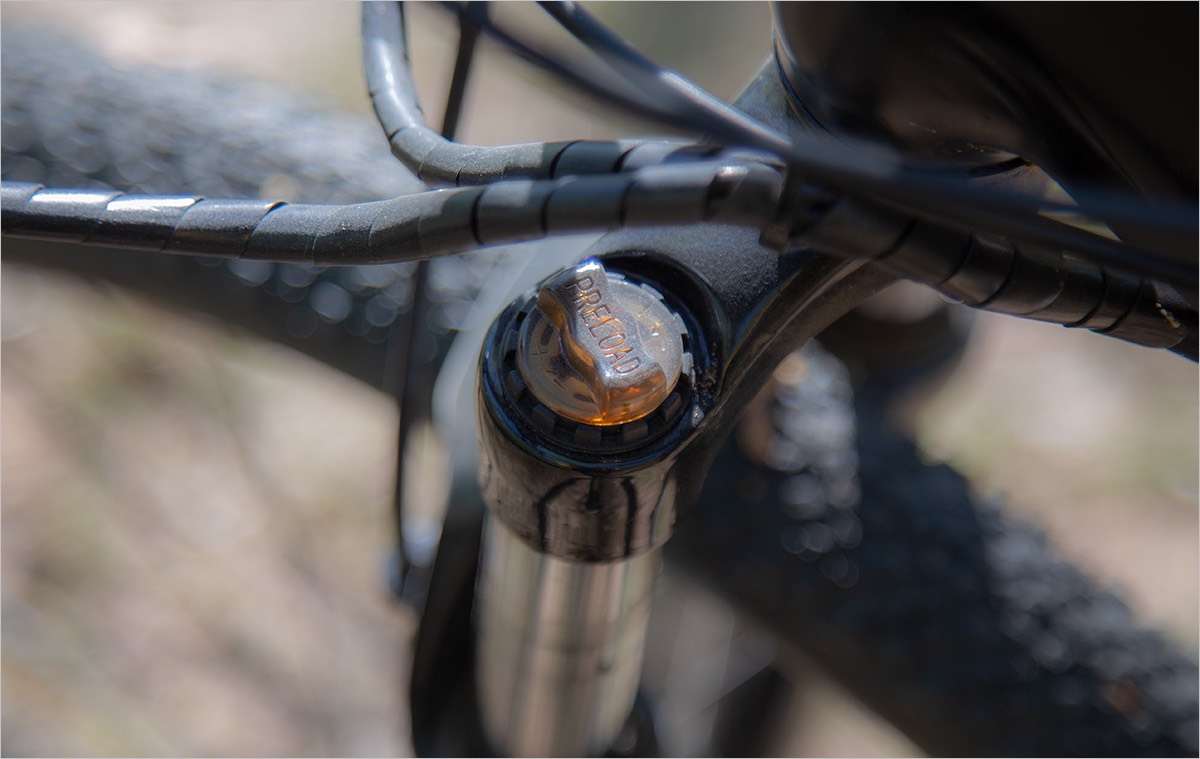
So what else is left of what you didn’t look at? Ah, the most interesting! Steering wheel and body kit on it!
The wheel is the most common MTB-shny (from Retrospec), on a small offset.

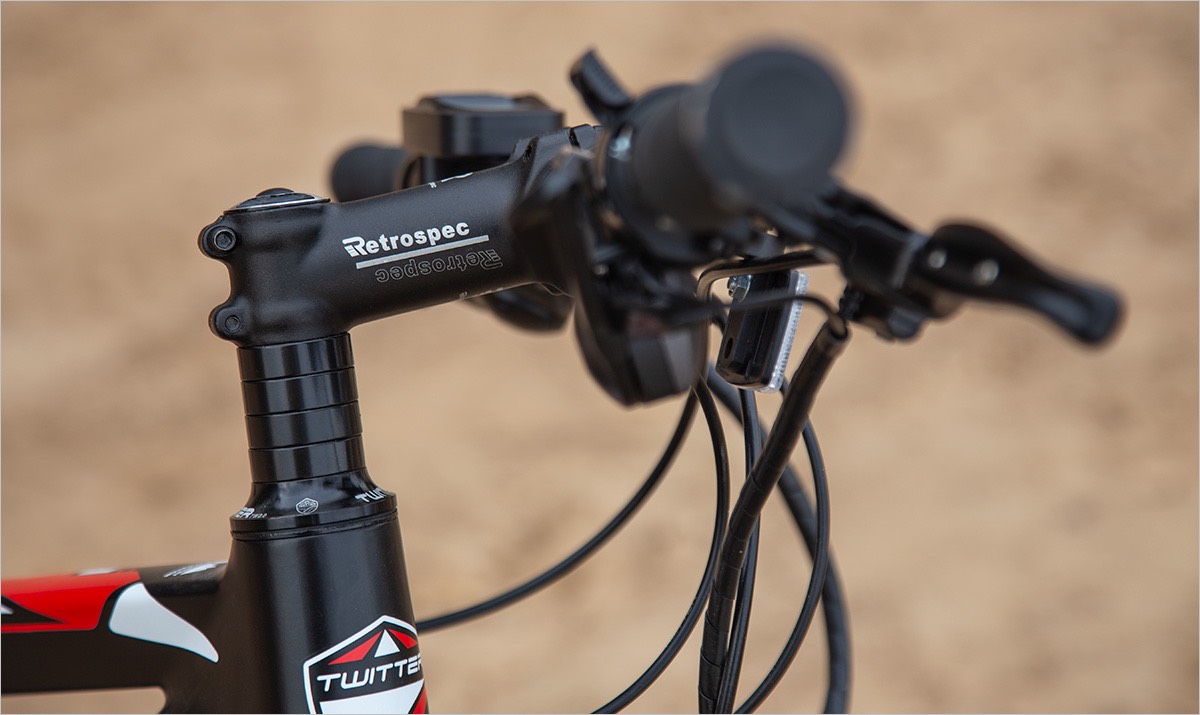
Along the edges - rubberized grips, which 1) differ from those that appear on the site 2) are not very convenient on long trips and dirt gets clogged in them 3) can be changed at any time.
In the vicinity of the handles there are speed shifters (on the left - front, on the right - rear): I really liked how they work, but the speed marking seemed a bit strange - only boundary values were noted (1 - 3, 1 - 9). Although if this is not your first time driving, you will not pay attention to indicators.

There are also brake handles. Initially, they are not very conveniently exposed, I had to turn them / tighten them “for myself”.
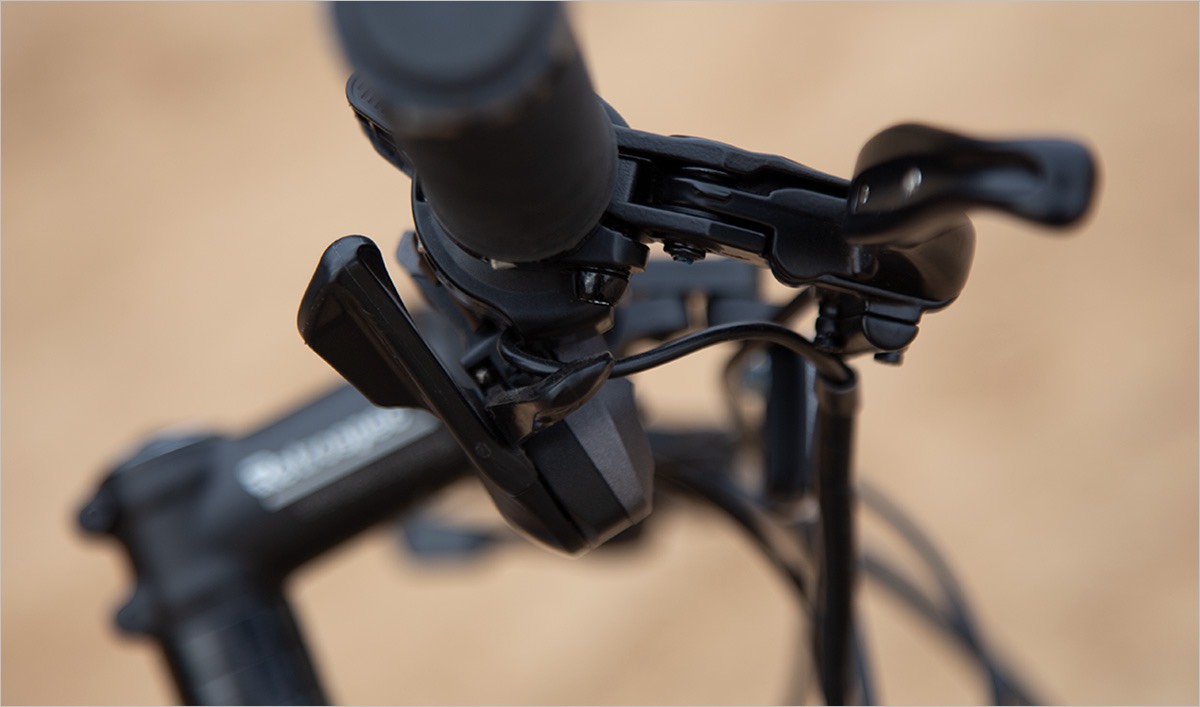
Well, as a cherry on the cake: on the handle on the left - the on-board computer, and on the right - a petal for turning on electromotor magic. And this and that is conveniently located, although the on-board computer looks more familiar (and more comfortable for reading information) in the central part of the steering wheel. If in the same Mantis the on-board computer was separate from the engine control buttons, then here they are combined in one device with three buttons: “M” (on / off) and “lower / increase” power.


Cable management ... well, to some extent it is present: part of the wires goes inside the frame (brake cables), part is attached with ties.
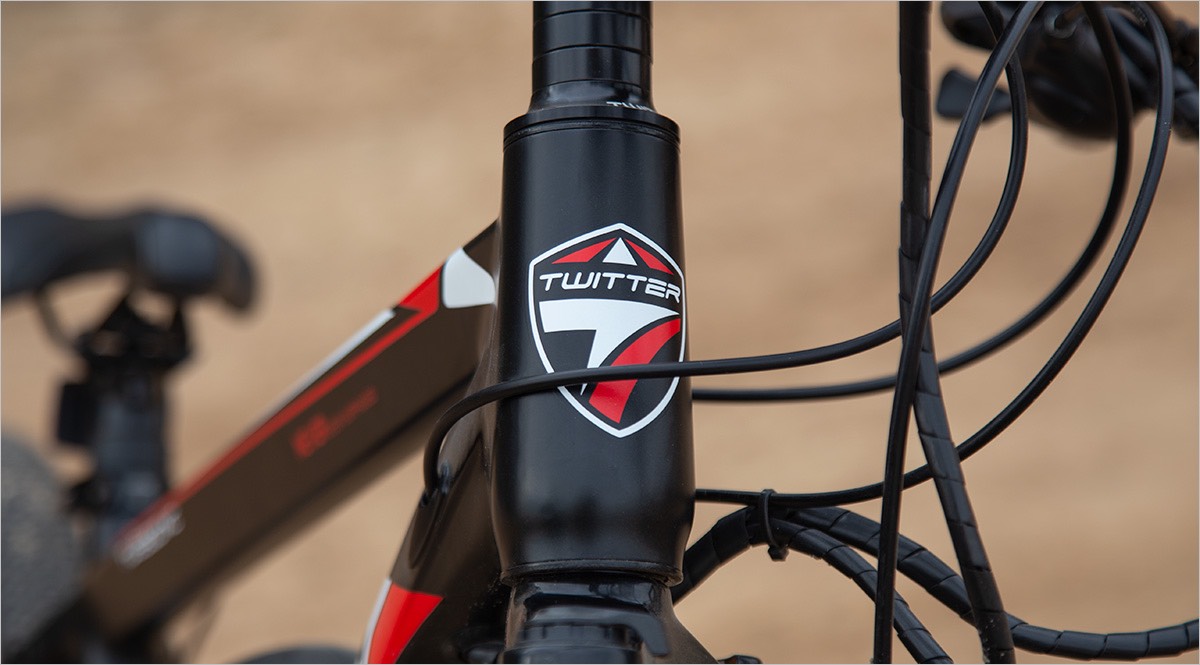

There are slightly more wires than usual - additional ones are provided by the “scooter” mode - from the brake to the motor, so that the motor does not continue to work during braking. When there are so many wires - you can hardly organize everything neatly for a reasonable price. The most “terrible” is not visible, but from below (but also not critical):

With the appearance, everything seems to be. We stretch out all the eccentrics (on wheels, at the saddle), cogs ... and go!
If it were not for the motor and the battery, then Twitter VS7.0-ER was an average bike, but it would not be so interesting and appropriate (on the Habr) - you can pedal on any bike. But it’s worth pressing two buttons ... and two new modes will be added to the muscular traction mode: the assist mode (when the motor helps to pedal) and the scootercheater mode (when the bike carries you yourself, and you rest).
First of all, we charge the battery - for this, a charger (54.6 V, 2 A), ahem, with a fan comes with the bike. Well ok, let it buzz - there’s less chance that the filling will melt. A full charge cycle is 5-6 hours - a long time, but this is enough for a long time, that is, you do not have to charge the bike every day. Like a 20,000 paverbank in the bowels of the backpack :)
To call for electrical assistance, you should press the red button under the rubber cover on the battery (which you can not turn off at all, except for long periods of inactivity - for example, in winter). And then - hold down the "M" button on the on-board computer. The screen will immediately light up, but it will not show the “power reserve” in kilometers - instead of it, the battery charge is in%. As well as mileage (per trip or all time) and the current level of assistance of the electric motor. Five levels - 0 (does not help) and from 1 to 5 (it is regulated by buttons "+" and "-" on the remote control). The higher the level, the more the motor will help with each pedal rotation (which monitors the PAS in the area of the carriage; pedal sensor): if you still have to sweat on the “unit”, then you can go to “5” even up the hill on the “heaviest stars” effortlessly rested. During assisting, there is a not very loud, but hum.
During the tests, I really enjoyed riding the VS7.0-ER in all three modes:
The brakes performed exceptionally well, but soon a creak appeared in the front wheel - it was removed by adjusting it relative to the brake disc.
Information from the screen is read in any weather (even in bright sun, unlike the computer in TW-E9L) and even in the dark (due to the backlight), but, as I wrote above, in the central part of the steering wheel it would look “more convenient” .
Two points that did not like:
Otherwise, it is exceptionally pleasant, with an equally pleasant “price / quality” ratio.
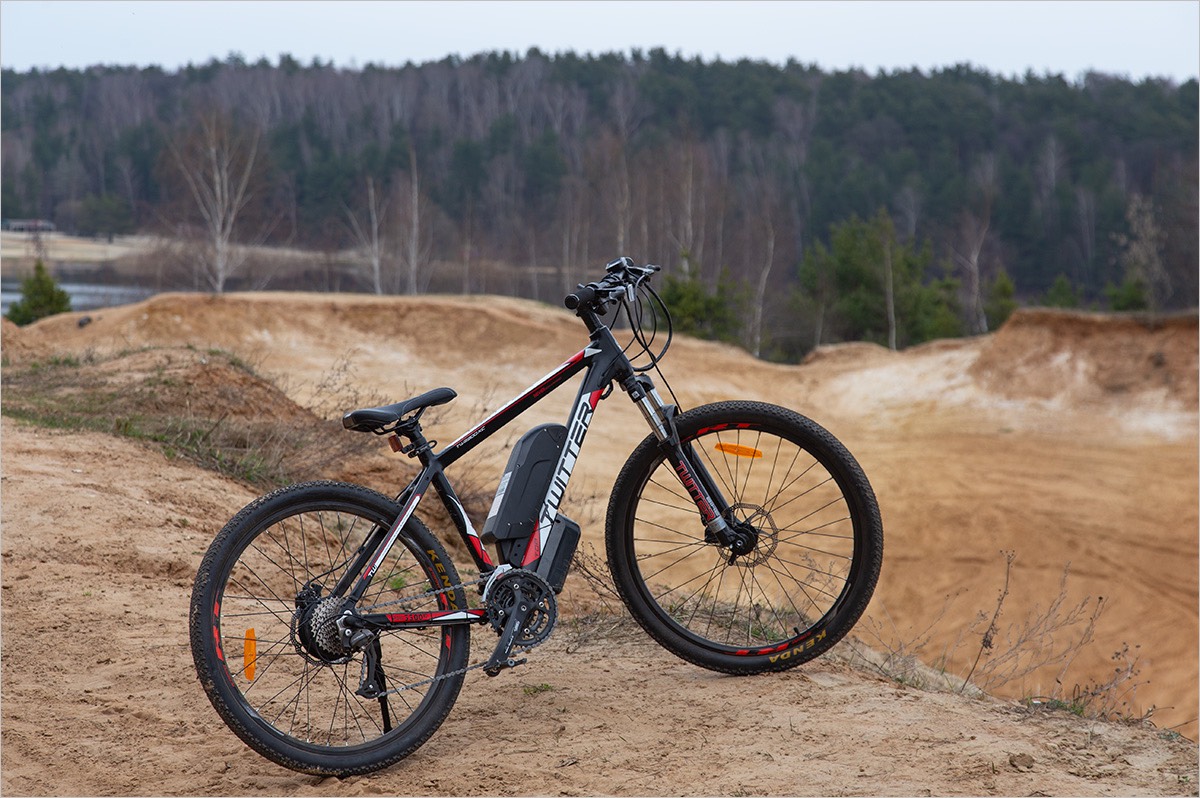
Wheel size: 26 "
Frame size: 17.0"
Bicycle color: Black-red / black-yellow / white-red
Bicycle weight: 19.8 kg
Frame: Aluminum alloy 6061
Handlebar: Aluminum alloy with a matte finish
Fork: Retrospec, with manual lock
Steering column : Aluminum alloy, 44 mm CNC
Gear shift levers: Shimano Altus, 27 speeds
Front gear selector: Shimano Altus
Rear gear selector: Shimano Altus
Connecting rods: Aluminum alloy, square hole, 22-32-44T
Cassette: SUGEK-9S, 11-34T
Chain:YBN-9S
Carriage: KENLI, square bores, bearing BB68
Brakes: Shimano Tourney, mechanical disc
Hubs: RS, aluminum alloy, 2-bearing, for disc brakes
Rims: Retrospec RS300, aluminum alloy, double pistoned
Spokes: SHUNJIU, heavy-duty
Tires : KENDA-1187, 26 "× 1.95"
Handles: Retrospec
Saddle: Retrospec
Pedals: Retrospec CNC, for mountain bikes, on bearings, aluminum alloy.
Modes of use: 3
modes. Help modes: 5 modes.
Mileage on one charge:40 km (in scooter mode), up to 120 km (in help mode)
Maximum speed: Up to 35 km / h
Maximum user weight: 120 kg
Battery: LG-18650 lithium-ion, 48 V, 10 A · h
USB port for charging gadgets
Full charging time: 5-6 hours
Number of recharge cycles: 800-1000 times
Motor: Rear wheel motor, 48 V, 350 W
Brushless DC motor with reduced noise
Maximum torque: 60 N · m
Controller: 5 modes of use
Monitor: LCD display
Monitor functions: Speed, mileage, charge level, mode, etc.
Settable parameters: Mileage reset, wheel size, etc.

Yes, by the way - Twitter VS7.0-ER is available in three colors: black-red (as in the review), black-green and white-red. Everyone has the same price - 64 990 ₽ .
Read also reviews on other electric bikes:
- Twitter Mantis-E0
- Twitter Mantis E-1
- Twitter TW-E9L
- Airwheel R8

In large cities (especially in Moscow), a car is increasingly turning from a means of transportation into a luxury: gasoline, traffic jams, parking, taxes, thousands of fines. But abandoning a personal car can be difficult - each of us has situations where neither a taxi nor car sharing will replace it. Metro, buses, trams ... yes, everything is fine, but often you need to get to the same metro, and public transport is rigidly tied to routes and not always convenient.
Scooters, monowheels, rollers? Yes, it is compact, maneuverable and economical, but all this is convenient only at short distances - it’s obviously inconvenient to go from the Moscow region to the center on roller / monowheels. Whether it’s an electric bike business, he sat down and rode away: at least for 20 km, at least for 50, if you want to drive a motor, if you want by the power of your two, you definitely won’t have to drag. Well, plus the health benefits and shape. Anyway, summer is made for a bicycle. What is needed?
The lineup
In the model range of the VS7.0 line there are already three versions of electric bikes : VS7.0-ER100 , VS7.0-ER and VS7.0-EM . Visually, they look almost the same, but only one letter / number significantly affects both the characteristics and the price. We have already briefly talked about this in a consolidated publication , but it will not be a sin to repeat it.
VS7.0-ER100 | VS7.0-ER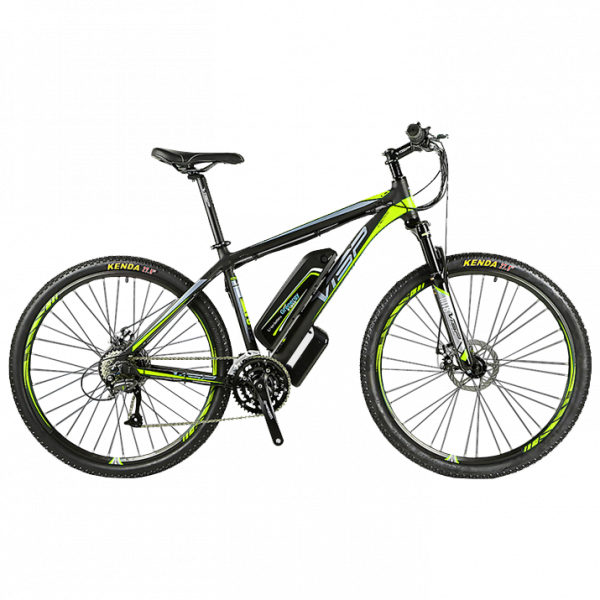 | VS7.0-EM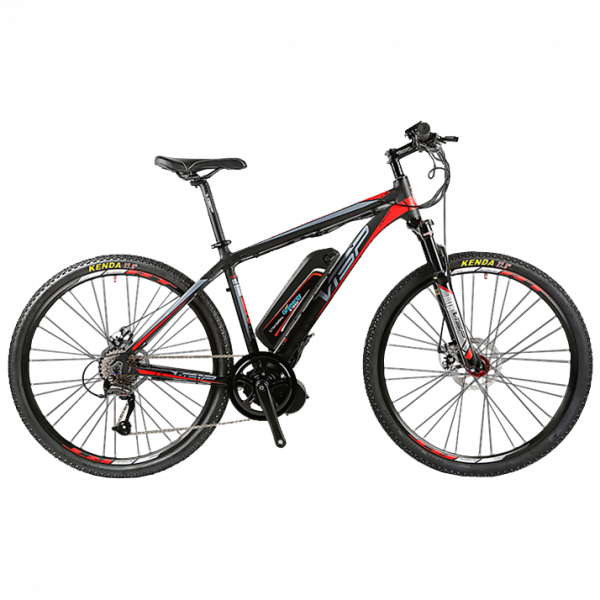 |
|---|
- VS7.0-ER100
The most affordable electric bike in the lineup is designed for measured driving in the city and beyond. Equipped with Shimano switches and brakes of the Tourney and Altus series. 21 speeds, three driving modes. In hybrid mode, the model provides five different options for the operation of the electric motor. With a weight of almost 20 kg, it develops speeds of up to 35 km / h and is capable of driving on a single charge in scooter mode up to 30 km.
→ Full specifications - VS7.0-ER (model from the review)
Despite the “simpler” name, it is more feature-rich (compared to its “brother” above):
- Engine power with a gearbox of 350 W compared to 250 W in the ER100;
- Battery capacity of 480 Wh; h compared with 360 Wh;
- The maximum mileage in help mode is up to 120 km instead of 90 km on the ER100, and in scooter mode - up to 40 km instead of 30.
→ Full details - VS7.0-EM
The most stuffed model, withstands more weight due to its construction. Shimano Alivio shifters and shifters are installed on it - a higher class than Altus and Tourney. Instead of a motor-wheel, the VS7.0-EM uses a carriage motor with the largest torque in the line - 80 Nm (instead of 60 for the models above). And at the same time - a more comfortable weight distribution (when climbing uphill with the drive turned off, this is noticeable), which also provides more convenient maintenance. Autonomy is the same as the ER version.
→ Full specifications
Appearance
Today there will be no photos without specks of dust, to the comments “how can you give a bike like that!” we are ready. Moreover - we plan to make a separate publication about the maintenance of a bicycle by the example of a tricked two-suspension (which fell most of all under distribution) - would it be interesting to read? Write your questions in the comments.

The bike starts with a frame. The VS7.0-ER is a typical aluminum (6061) triangle with a size of 17 "- the 15-inch version (as, for example, the Mantis line) or some other is not here. The upper and lower pipes of the frame have a slightly" triangular "section, while the seatpost is round, and neat seamless welding is used, which adds points to the look of the bike.

But what removes the points is the controller unit located under the bottom of the frame - it looks somewhat bulky and unusual, in the models from the previous review all the electronics were hidden either in the battery (in the Mantis series models) or in the frame itself (as in the carbon TW -E9L ). But there are pluses in this - servicing such a unit (in which case) will be easier than picking the same frame. On the go, this box also does not interfere in any way - it is not the bottom point and does not hurt anything.

The bicycle’s battery is located on the bottom tube of the frame - it is removable (worn along the guide), with a mechanical anti-theft lock (2 keys in the kit) and with a charge indicator (there is a separate button for this).

He also has a rubberized plug under which there is a USB-connector for charging devices, a connector for charging the battery itself and a button for turning it off in hardware.

The USB connector turns the bike into a large power bank: if you want, charge the smartphone (the same trackers quickly erase the charge of the smartphone), you want the column (which you have nowhere to attach), you want the flashlight. U - convenient.
 The battery capacity is 480 Wh (48 V, 10 Ah). Inside - lithium-ion cells of LG (judging by the name of the model, CBT-13S3P, there are 13 consecutive blocks of 3 parallel cells of 18650) - the manufacturer claims up to 120 km on a single charge in the assist mode.
The battery capacity is 480 Wh (48 V, 10 Ah). Inside - lithium-ion cells of LG (judging by the name of the model, CBT-13S3P, there are 13 consecutive blocks of 3 parallel cells of 18650) - the manufacturer claims up to 120 km on a single charge in the assist mode. A lot, a little? How many trips do you drive 120 km?
There are three stars in the front cassette, 9 in the back, a total of 27 speeds. You will once again write that you can’t ride all of them for a long time, but you won’t argue against mathematics - 3 by 9 equals 27 :) Cassette - SUGEK-9S (11-34T), choosing a comfortable riding mode is not a problem.

As mentioned above, the Shimano Altus kit (more precisely the M370) is responsible for switching speeds here - an inexpensive and relatively high-quality switch designed for entry-level and mid-range MTBs.


The manufacturer calls the design of the switch low profile (like the frame is pressed closer to the cassette stars - for better switching, less resistance and to make the hair smooth and silky), as well as increased dirt resistance. We checked on several long and "dirty" trips - the flight is normal. There is a cable tension adjuster for fine tuning.

Chain YBN-9S
Brakes - mechanical disc. Shimano Tourney TX - suitable for Altus class, simple and unpretentious, with perforated discs and fairly large pads.



By the way, yes, the wheels are 26-inch, with a Retrospec rim (as in previous models, almost all the equipment here is from this brand) and KENDA-1187 tires (26 "× 1.95"). The same tires were in more MTB models, for example, in Twitter Mantis - nothing has changed since the last reviews, they are still as comfortable driving around the city and offroad.


A brushless electric motor (gear motor-wheel) with the marking 48V350W18054609 is built into the rear wheel. I'm certainly not a doctor, but there is a feeling that it is designed for a voltage of 48 V, and the power is 350 watts. That technical specifications confirm :) The gearbox has a freewheel (so as not to expend energy when driving on muscular traction). About the impressions of riding on such a motor - a little later.


The seat post allows you to adjust the seat height (convenient eccentric) in a fairly wide range - from "bmx-style" to "for a special project " :) The seat is made of eco-leather, comfortable, does not rub over long distances.

Two reflectors are included in the kit: one is just under the saddle, the second is on the steering wheel.

Cranks and pedals from Retrospec - more than once met, no complaints. Also, the bike is equipped with a footrest installed on the rear left feather - so that the bike can be beautifully placed and inform social networks the next trip.


The front wheel has a suspension fork with the ability to lock it (manual) and adjust the “preload” (fork position in a state of static load). The stroke is about 100 mm. There is no rear shock absorber - we have an inexpensive hardtail for the city and parks :) But it’s worthwhile to pay tribute, riding with even one shock absorber is quite comfortable.



So what else is left of what you didn’t look at? Ah, the most interesting! Steering wheel and body kit on it!
The wheel is the most common MTB-shny (from Retrospec), on a small offset.


Along the edges - rubberized grips, which 1) differ from those that appear on the site 2) are not very convenient on long trips and dirt gets clogged in them 3) can be changed at any time.
In the vicinity of the handles there are speed shifters (on the left - front, on the right - rear): I really liked how they work, but the speed marking seemed a bit strange - only boundary values were noted (1 - 3, 1 - 9). Although if this is not your first time driving, you will not pay attention to indicators.

There are also brake handles. Initially, they are not very conveniently exposed, I had to turn them / tighten them “for myself”.

Well, as a cherry on the cake: on the handle on the left - the on-board computer, and on the right - a petal for turning on electromotor magic. And this and that is conveniently located, although the on-board computer looks more familiar (and more comfortable for reading information) in the central part of the steering wheel. If in the same Mantis the on-board computer was separate from the engine control buttons, then here they are combined in one device with three buttons: “M” (on / off) and “lower / increase” power.


Cable management ... well, to some extent it is present: part of the wires goes inside the frame (brake cables), part is attached with ties.


There are slightly more wires than usual - additional ones are provided by the “scooter” mode - from the brake to the motor, so that the motor does not continue to work during braking. When there are so many wires - you can hardly organize everything neatly for a reasonable price. The most “terrible” is not visible, but from below (but also not critical):

With the appearance, everything seems to be. We stretch out all the eccentrics (on wheels, at the saddle), cogs ... and go!
Test
If it were not for the motor and the battery, then Twitter VS7.0-ER was an average bike, but it would not be so interesting and appropriate (on the Habr) - you can pedal on any bike. But it’s worth pressing two buttons ... and two new modes will be added to the muscular traction mode: the assist mode (when the motor helps to pedal) and the scooter
First of all, we charge the battery - for this, a charger (54.6 V, 2 A), ahem, with a fan comes with the bike. Well ok, let it buzz - there’s less chance that the filling will melt. A full charge cycle is 5-6 hours - a long time, but this is enough for a long time, that is, you do not have to charge the bike every day. Like a 20,000 paverbank in the bowels of the backpack :)
To call for electrical assistance, you should press the red button under the rubber cover on the battery (which you can not turn off at all, except for long periods of inactivity - for example, in winter). And then - hold down the "M" button on the on-board computer. The screen will immediately light up, but it will not show the “power reserve” in kilometers - instead of it, the battery charge is in%. As well as mileage (per trip or all time) and the current level of assistance of the electric motor. Five levels - 0 (does not help) and from 1 to 5 (it is regulated by buttons "+" and "-" on the remote control). The higher the level, the more the motor will help with each pedal rotation (which monitors the PAS in the area of the carriage; pedal sensor): if you still have to sweat on the “unit”, then you can go to “5” even up the hill on the “heaviest stars” effortlessly rested. During assisting, there is a not very loud, but hum.
During the tests, I really enjoyed riding the VS7.0-ER in all three modes:
- In bicycle mode, this is a good-quality bike with MTB manners, trouble-free gear changes, effective brakes and a rather soft “suspension”.
- In the assistance mode - all the same solid is great, but with the ability to increase the distance of arrival, which helps in difficult situations. Personally, my comfortable “bar” - in the region of 30 km at a time (along a forest road) - on a regular bicycle after this distance, my legs “clog”, my lower back and wrists get tired, and my feet begin to “burn”. And then I drove through 40+ - yes, there was still some discomfort, but at least I didn’t have to go “by force”.
- In scooter mode - the most cheating option, but if it is, then sometimes it’s a sin not to use it. For example, I turned it on when I had to answer a message on the phone - pedaling is harder to do (they say you can still stop, but these are not our methods). Or get to work - if it is 20-30 km, then one charge will be enough to get there and back on one electric traction. Yes, even if more than 30 km one way - you can remove the battery and charge it during operation. You don’t need to fill in gasoline or stand in traffic jams or look for a parking space - he threw up his backpack, pressed a button and drove off (dry). In the summer - a buzz inaccessible to a regular bicycle.
In this mode, the bike on a smooth road can accelerate (somewhere in 15 seconds) to 35 km / h - a fairly high speed. At a higher motor the engine shuts off, so if you want to overtake cars, then this opportunity is at your feet :) Well, or change to a highway.
The brakes performed exceptionally well, but soon a creak appeared in the front wheel - it was removed by adjusting it relative to the brake disc.
Information from the screen is read in any weather (even in bright sun, unlike the computer in TW-E9L) and even in the dark (due to the backlight), but, as I wrote above, in the central part of the steering wheel it would look “more convenient” .
Two points that did not like:
- The kit does not have a headlight (to illuminate the road ahead) and a rear light (to be more visible on the road). Yes, it’s not a tragedy and you can buy the right one for your choice, but 1) “out of the box” is not ready for night rides 2) in retail it will be more expensive than the wholesale batch to the manufacturer and 3) in the same Airwheel R8 there was a built-in light and it was cool. Ah, well, the wings wouldn’t be crazy.
- The bike is still heavy (almost 20 kg), especially the rear part due to the motor wheel (although the battery adds about 2.5 kg). An engine in the carriage (as in version VS7.0-EM) would probably make the bike more balanced. No, it doesn’t have much effect during the ride, but if you live on the 4th floor of a five-story building without an elevator, then it’s noticeable :)
Otherwise, it is exceptionally pleasant, with an equally pleasant “price / quality” ratio.

Technical specifications Twitter VS7.0-ER
Wheel size: 26 "
Frame size: 17.0"
Bicycle color: Black-red / black-yellow / white-red
Bicycle weight: 19.8 kg
Frame: Aluminum alloy 6061
Handlebar: Aluminum alloy with a matte finish
Fork: Retrospec, with manual lock
Steering column : Aluminum alloy, 44 mm CNC
Gear shift levers: Shimano Altus, 27 speeds
Front gear selector: Shimano Altus
Rear gear selector: Shimano Altus
Connecting rods: Aluminum alloy, square hole, 22-32-44T
Cassette: SUGEK-9S, 11-34T
Chain:YBN-9S
Carriage: KENLI, square bores, bearing BB68
Brakes: Shimano Tourney, mechanical disc
Hubs: RS, aluminum alloy, 2-bearing, for disc brakes
Rims: Retrospec RS300, aluminum alloy, double pistoned
Spokes: SHUNJIU, heavy-duty
Tires : KENDA-1187, 26 "× 1.95"
Handles: Retrospec
Saddle: Retrospec
Pedals: Retrospec CNC, for mountain bikes, on bearings, aluminum alloy.
Modes of use: 3
modes. Help modes: 5 modes.
Mileage on one charge:40 km (in scooter mode), up to 120 km (in help mode)
Maximum speed: Up to 35 km / h
Maximum user weight: 120 kg
Battery: LG-18650 lithium-ion, 48 V, 10 A · h
USB port for charging gadgets
Full charging time: 5-6 hours
Number of recharge cycles: 800-1000 times
Motor: Rear wheel motor, 48 V, 350 W
Brushless DC motor with reduced noise
Maximum torque: 60 N · m
Controller: 5 modes of use
Monitor: LCD display
Monitor functions: Speed, mileage, charge level, mode, etc.
Settable parameters: Mileage reset, wheel size, etc.

Yes, by the way - Twitter VS7.0-ER is available in three colors: black-red (as in the review), black-green and white-red. Everyone has the same price - 64 990 ₽ .
Read also reviews on other electric bikes:
- Twitter Mantis-E0
- Twitter Mantis E-1
- Twitter TW-E9L
- Airwheel R8
